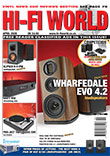Page 2 of 4
SOUND QUALITY I’m talking only tonal balance here. Transparency and insight are other important properties and here the ESL-57s were unmatchable. They see through everything, being brutally frank about recording quality and balance. As much as I enjoy old classics like Billy Idol’s 'White Wedding', or Steve Earle’s 'Copperhead Road', they sounded dated with these loudspeakers. The recordings were ill balanced or congested, the Quads told me. Yet at the same time, whilst limitations in recording quality were starkly revealed, I was fed Steve Earle and Billy Idol at the microphone like never before: fantastic!
Spinning a good, modern recording on DVD-A like Toy Matinee’s 'Turn it on Salvador', the extra resolution of 24bit at 96kHz was glaringly apparent. Instruments were sparkling clean, vocals starkly clear: what revelation! Where a big Tannoy brings lusty dynamics to all sources, the Quads perform analytical surgery on a scale unknown to most - loudspeakers or men that is! - laying bare both performances and the technology used to capture them.
These particular ESL-57s are about the most revealing loudspeakers I have ever heard, helped by the fact that they have been built with just that property in mind. The modifications One Thing make, such as a lighter diaphragm film, give subjective improvements that capitalise upon the loudspeakers intrinsic strengths, moving it even further ahead of the herd. Quad ESL-57s do not have deep bass, nor a full bodied or warm sound. Being an open dipole, exactly what you get from them depends much upon the room and their positioning within it. In a suitable room I have heard 57s give bass of a quality, if not a power, far beyond any box loudspeaker, but this is rare. Basically, 57s peak up in the upper bass region (90Hz) and roll off below this point. You get a form of bass, but it has no great depth nor thunderous strength - at least, in my room. A subwoofer can help.
Quads benefit from having some space behind them, to ‘lose’ sound from the rear. This, and their size, mean that a largish room is best. Long narrow rooms measuring 20x12ft or thereabouts are ideal, with each panel end-on against or close to the side wall, facing down the room. Positioned like this the side walls augment bass from the panel and the rear wave is usefully attenuated. An alternative is to place absorptive panels a small distance behind each speaker, using acoustic foam or similar. Do not expect to place any open panel, including this one, flat against a wall, nor anywhere near it.
Remembering back to earlier Quad electrostatics I have used, these upgraded ESL-57s are easily the most revealing. One Thing say they are a big improvement upon those we reviewed in our October 2003 issue. Everything editor DP found was repeated with these upgrades. They were spectacular with large orchestral works, bringing an open, airy sound to Wagner for example; horns had strength, yet sounded wonderfully rich and natural. They called out magisterially from a vast sweep of an orchestra, strings behind sounding as smooth yet finely differentiated as you could ever wish for. A roll on a kettle drum had more power to it than I am used to, resonating nicely around my room. I fancy these ESL-57s have better dynamics, more volume and generally more vivacity and speed than I am accustomed to from any electrostatic I have heard before.
There is some slight sense of the metal front grilles being there still; I can perceive this because I have used 63s bare. All the same, when you hear natural instruments, like woodwinds, horns and violins through electrostatics as good as these you are reminded just how their lush timbral properties are twisted and sat upon by ordinary loudspeakers. Quads bring life to the gentle tranquility of orchestral ensembles, as they don’t lose resolution at low levels yet, in Lohengrin, when the orchestra rises to a brief crescendo it does so with a sudden force that is breathtaking through these 57s.
The same revelation the Quads bring to Rock vocals they also bring Classical vocals. There was a gentle purity to Renee Fleming’s voice singing 'Madame Butterfly'; it was a simple, uncluttered sound yet at the same time richly detailed and finely nuanced. And what they bring to Renee Fleming on CD, they improve upon with Eleanor McEvoy on SACD, as this source is the best we have at present, a quality these Quads are able to completely reveal. |
Search
Hi-Fi World, Powered by Joomla!; Hosted by Joomla Wired.







